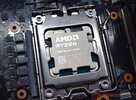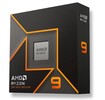AMD Ryzen 7 8700G vs AMD Ryzen 5 9600X vs AMD Ryzen 9 9900X
AMD Ryzen 7 8700G
► remove from comparison
The AMD Ryzen 7 8700G is a powerful SoC based on AMD's Zen 4 architecture and has found its way from the notebook segment into the desktop sector. The APU combines strong CPU performance with the powerful iGPU, which is already used as the AMD Radeon 780M in many laptops and mini PCs.
CPU Performance
The Ryzen 7 8700G has 8 cores and 16 threads supported by Simultaneous Multithreading (SMT). This multithreading capability ensures that the processor works efficiently even with intensive tasks such as multitasking or complex applications. With a base clock speed of 4.2 GHz, which can be increased to up to 5.1 GHz in Turbo mode, the Ryzen 7 8700G offers outstanding computing power without requiring an enormous amount of energy.
Integrated graphics unit aka AMD Radeon 780M
A special feature of the Ryzen 7 8700G is its integrated Radeon graphics unit, which makes it an all-in-one solution for compact systems such as mini PCs (e.g. Minisforum MS-A1). This graphics unit offers sufficient performance for gaming in low to medium settings and simultaneously enables smooth video and image editing. What is particularly impressive is that the integrated graphics are significantly more powerful than conventional onboard GPUs, making the use of a separate graphics card superfluous in many scenarios.
Energy efficiency and thermal performance
The Ryzen 7 8700G is also designed for energy efficiency. With a TDP (Thermal Design Power) of 65 watts, it offers an excellent performance to power consumption ratio, making it ideal for small systems with limited cooling units.
AMD Ryzen 5 9600X
► remove from comparison
The AMD Ryzen 5 9600X is a mid-range desktop CPU of the Granite Ridge product family that sports 6 Zen 5 cores (12 threads) running at 3.9 GHz to 5.4 GHz along with PCIe 5 support and a basic RDNA 2 architecture iGPU. The Ryzen was launched in June 2024, with sales slated to start some time in August.
Architecture and Features
Like Strix Point APUs, Granite Ridge processors make use of the new Zen 5 microarchitecture. However, there are no efficient cores here; all of 9600X's cores are full Zen 5 cores with a "proper" Zen 5 implementation, not the simplified mobile version that has a lower AVX-512 performance. Furthermore, Granite Ridge is a multi-die design with only the CPU cores produced using a fairly modern 4 nm TSMC process. Strix Point processors are a single-die design, from what we know.
According to AMD, Zen 5 delivers a 16% IPC uplift over Zen 4 thanks to branch prediction improvements and other refinements.
Elsewhere, the 9600X has 32 MB of L3 cache and 24 direct PCIe 5 lanes (3.93 GB/s throughput per lane) with up to 12 additional PCIe 4 lanes available depending on the motherboard. It supports DDR5 RAM as fast as 5,600 MT/s (up to 8,000 MT/s if overclocked).
The Ryzen 5 is unlocked for overclocking. Naturally, this AM5 socket CPU fully supports Windows 11, 64-bit Windows 10 as well as many Linux distros.
Performance
In our review, the 9600X delivered multi-thread performance similar to what the Intel Core Ultra 9 185H, AMD Ryzen AI 9 365, Core i5-12600K, Ryzen 7 8700G as well as the octa-core AMD Ryzen 7 7800X3D deliver which is pretty impressive considering the price.
Graphics
The Radeon 610M comes equipped with just 128 unified shaders running at up to 2,200 MHz. Its gaming performance is extremely low but still sufficient for competitive titles (Counter-Strike 2 is perfectly playable at 1080p / Low) as well as really old titles (pre-2019).
It can HW-decode many popular video codecs including first and foremost AVC, HEVC, VP9, AV1.
Power consumption
The CPU cores are built with TSMC's N4P process which delivers a good, as of mid 2024, power efficiency. (Apple is the leader in this regard with the second-generation 3 nm process.)
The Ryzen 5's long-term TDP is either 65 W or 105 W, with each user free to make their own choice. Overclocking the chip will cause its power consumption figures to go up significantly.
AMD Ryzen 9 9900X
► remove from comparison
The Ryzen 9 9900X is fast desktop processor of the Granite Ridge product family that sports 12 Zen 5 cores (24 threads) running at 4.4 GHz to 5.6 GHz, PCIe 5 support and a basic RDNA 2 architecture iGPU. The Ryzen was launched in June 2024, with sales slated to start some time in August.
Architecture and Features
Like Strix Point APUs, Granite Ridge processors make use of the new Zen 5 microarchitecture. However, there are no efficient cores here; all of 9900X's cores are full Zen 5 cores. Furthermore, Granite Ridge is a multi-die design with only the CPU cores produced using a fairly modern 4 nm TSMC process. Strix Point processors are a single-die design, from what we know.
According to AMD, Zen 5 delivers a 16% IPC improvement over Zen 4 thanks to branch prediction improvements and other refinements.
Elsewhere, the 9900X has 64 MB of L3 cache and 24 direct PCIe 5 lanes (3.93 GB/s throughput per lane) with up to 12 additional PCIe 4 lanes available depending on the motherboard. It supports DDR5 RAM as fast as fast as 5,600 MT/s (up to 8,000 MT/s if overclocked).
The 9900X is unlocked for overclocking. Naturally, the AM5 socket CPU fully supports Windows 11, 64-bit Windows 10 as well as many Linux distros.
Performance
If early July leaks are any indication, the CPU delivers multi-thread performance on par with the AMD Ryzen 9 7950X and the Intel Core i7-14700K. We'll update this section once we get our hands on a system powered by the 9900X.
Graphics
The Radeon 610M comes equipped with just 128 unified shaders running at up to 2,200 MHz. Its gaming performance is slated to be extremely low and only just sufficient for pre-2020 games in resolutions such as 1024x768.
Power consumption
The CPU cores are built with TSMC's N4P process for good, as of mid 2024, power efficiency. (Apple is the leader in this regard with the second-generation 3 nm process.)
The Ryzen 7's long-term TDP is 120 W. It'll probably consume at least 170 W when under heavy short-term loads. If overclocked, the power consumption figures will increase significantly.
| Model | AMD Ryzen 7 8700G | AMD Ryzen 5 9600X | AMD Ryzen 9 9900X | ||||||||||||||||||||||||||||||||||||||||||||||||
| Codename | Phoenix | Granite Ridge | Granite Ridge | ||||||||||||||||||||||||||||||||||||||||||||||||
| Series | AMD Phoenix (Zen 4) | AMD Granite Ridge (Zen 5, AM5) | AMD Granite Ridge (Zen 5, AM5) | ||||||||||||||||||||||||||||||||||||||||||||||||
| Clock | 4200 - 5100 MHz | 3900 - 5400 MHz | 4400 - 5600 MHz | ||||||||||||||||||||||||||||||||||||||||||||||||
| L1 Cache | 512 KB | 768 KB | |||||||||||||||||||||||||||||||||||||||||||||||||
| L2 Cache | 8 MB | 6 MB | 12 MB | ||||||||||||||||||||||||||||||||||||||||||||||||
| L3 Cache | 16 MB | 32 MB | 64 MB | ||||||||||||||||||||||||||||||||||||||||||||||||
| Cores / Threads | 8 / 16 | 6 / 12 6 x 5.4 GHz AMD Zen 5 | 12 / 24 12 x 5.6 GHz AMD Zen 5 | ||||||||||||||||||||||||||||||||||||||||||||||||
| TDP | 65 Watt | 65 Watt | 120 Watt | ||||||||||||||||||||||||||||||||||||||||||||||||
| Transistors | 25000 Million | ||||||||||||||||||||||||||||||||||||||||||||||||||
| Technology | 7 nm | 4 nm & 6 nm | 4 nm & 6 nm | ||||||||||||||||||||||||||||||||||||||||||||||||
| Die Size | 178 mm2 | ||||||||||||||||||||||||||||||||||||||||||||||||||
| max. Temp. | 95 °C | 95 °C | 95 °C | ||||||||||||||||||||||||||||||||||||||||||||||||
| Socket | AM5 | AM5 | AM5 | ||||||||||||||||||||||||||||||||||||||||||||||||
| Features | DDR5-5200 RAM, PCIe 4, MMX, SSE, SSE2, SSE3, SSSE3, SSE4A, SSE4.1, SSE4.2, AES, AVX, AVX2, AVX-512, BMI1, BMI2, SHA, F16C, FMA3, NX-Bit, AMD64, EVP, AMD-V, SMAP, SMEP, SMT, Precision Boost 2, XDNA2 | DDR5-5600 RAM, PCIe 5 + PCIe 4, SMT, AES, AVX, AVX2, AVX512, FMA3, MMX (+), SHA, SSE, SSE2, SSE3, SSSE3, SSE4.1, SSE4.2, SSE4A | DDR5-5600 RAM, PCIe 5 + PCIe 4, SMT, AES, AVX, AVX2, AVX512, FMA3, MMX (+), SHA, SSE, SSE2, SSE3, SSSE3, SSE4.1, SSE4.2, SSE4A | ||||||||||||||||||||||||||||||||||||||||||||||||
| iGPU | AMD Radeon 780M (2900 MHz) | AMD Radeon 610M ( - 2200 MHz) | AMD Radeon 610M ( - 2200 MHz) | ||||||||||||||||||||||||||||||||||||||||||||||||
| Architecture | x86 | x86 | x86 | ||||||||||||||||||||||||||||||||||||||||||||||||
| $329 U.S. | |||||||||||||||||||||||||||||||||||||||||||||||||||
| Announced | |||||||||||||||||||||||||||||||||||||||||||||||||||
| Series: Granite Ridge (Zen 5, AM5) Granite Ridge |
|
| |||||||||||||||||||||||||||||||||||||||||||||||||
| Manufacturer | www.amd.com | www.amd.com |
Benchmarks
Average Benchmarks AMD Ryzen 7 8700G → 100% n=25
Average Benchmarks AMD Ryzen 5 9600X → 111% n=25
Average Benchmarks AMD Ryzen 9 9900X → 148% n=25
* Smaller numbers mean a higher performance
1 This benchmark is not used for the average calculation













